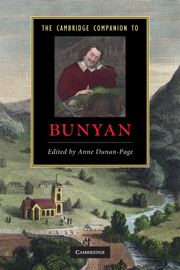Book contents
- Frontmatter
- Introduction
- Part I John Bunyan in his seventeenth-century context
- Part II John Bunyan’s major works
- Part III Readership and reception
- 10 Posthumous Bunyan: early lives and the development of the canon
- 11 The Victorians and Bunyan’s legacy
- 12 Bunyan: colonial, postcolonial
- Guide to further reading
- Index
10 - Posthumous Bunyan: early lives and the development of the canon
from Part III - Readership and reception
Published online by Cambridge University Press: 28 July 2010
- Frontmatter
- Introduction
- Part I John Bunyan in his seventeenth-century context
- Part II John Bunyan’s major works
- Part III Readership and reception
- 10 Posthumous Bunyan: early lives and the development of the canon
- 11 The Victorians and Bunyan’s legacy
- 12 Bunyan: colonial, postcolonial
- Guide to further reading
- Index
Summary
For most of his life, John Bunyan was despised. To clergymen of the Church of England he embodied the worst kind of sectarian fanaticism, and he was repeatedly accused of being a tinker, an 'emblem of lower-class vulgarity, drunkenness and promiscuity'. Charges of ignorance, dishonesty, blasphemy, fanaticism and heresy were levelled against him, and when he challenged the Anglican Edward Fowler his writings were compared to the 'brutish barkings' of a dog. There were concerns that the 'Fury' of such an ignorant 'Pestilent Schismatick' might infect the true doctrine of the English Church and Bunyan's right to preach was quickly challenged. He had to contend just as much with the dissenters. His dispute with the Quakers began with his first printed works: Some Gospel-truths Opened (1656) and his response to its critics, A Vindication of . . . Some Gospel-Truths Opened (1657). In the eyes of George Fox, one of his later antagonists, Bunyan was a liar and a false prophet whose principles were inconsistent, just as his judgement was erratic. Bunyan's reputation did not improve in 1659 when he was supposed to have supported, in print, the slanders of a Cambridgeshire woman, Margaret Pryor, who accused a Quaker widow of bewitching her and of changing her into a mare (Bunyan's pamphlet on the matter has not survived, if indeed it was ever written). Pryor was soon exposed as a lewd drunkard, the accused woman was acquitted by a jury in fifteen minutes and the accusation of witchcraft was turned against Bunyan. Even the Baptists thought Bunyan to be a traitor.
- Type
- Chapter
- Information
- The Cambridge Companion to Bunyan , pp. 137 - 149Publisher: Cambridge University PressPrint publication year: 2010

